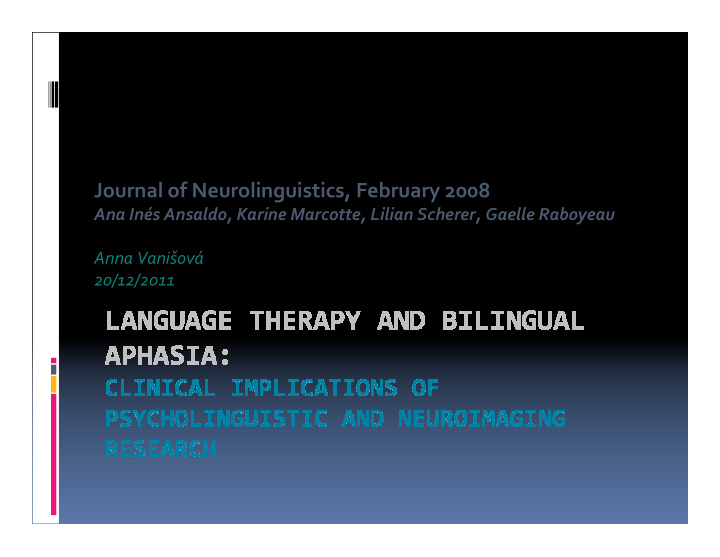



Journal of Neurolinguistics, February 2008 Ana Inés Ansaldo, Karine Marcotte, Lilian Scherer, Gaelle Raboyeau Anna Vanišová 20/12/2011
Why bilingual aphasia � Increasing nr. of bilinguals � bilingual aphasia hot topic � Clinical + theoretical research in communication sciences � Article � Recovery patterns � Issues of pathological LM, LS
Structure of the article � Introduction � Bilinguals, bilingualism � Bilingualisme within non-brain-damaged population � AoA, proficiency, LS, LM � Bilinguals and aphasia � Recovery patterns, AoA, proficiency, motivation, pathological LS, LM � Assesment and intervention � Therapy planning
Bilinguals and aphasia � Bilingual aphasia : Frequent form of aphasia � Necessary to consider the specificities of bil.aphasia � Age of acquisition � Proficiency level � Method of acquisition � Motivation
Age and method of acquisition � Related: � early bil – both lgs in natural context � Fewer deficits in both lgs � late bil – L1 natural context, L2 formal context � More impairments in L2 than L1 � Lesion to explicit memory circuits � Early bil – natural context � Parallel recovery � Late bil – formal context � Successive or differential recovery
Proficiency � Essential: i about pre-morbid lg performance � Pitres (1895): � recovering of lg that was most familiar � Contemporary research: � effect of therapy from spontaneous communicative situations
Motivation � Reasons: � Social � Emotional � Cultural � Cognitive
Normal and pathological LM and LS � Communicative situation � Bil with aphasia – despite the situation = PATHOLOGICAL LM & LS � Is there choice to lg choice? � Therapy offered in both lgs or limited to one lg? � Which lg then? � The most frequently used pre-morbidly? � The one least impaired? � The one with more emotional attachements?
Speach-language pathologists � Need to choose one lg (LM,LS) � Treating more lgs may inhibit global speech recovery � SLPs may favor rehabilitation of both lgs � bilingual lg system = unity � in bilingual environment
Considerations for therapy planning with bil aphasia � The relative intensity of use of either lg � The emotional value � Bilinguals with aphasia should not be deprived by limiting lg therapy to one lg � � bil aphasia requires bilingual rehabilitation lg system of bil person: both lgs � both should be � integrated in the therapy process � Bil therapy – not always possible � Depends upon the SLP resources
Conclusion � Therapy choice made on the basis of: � The possible impact of lesion location � Proficiency and method of acquisition � Therapeutic goal � To reduce the communication handicap � To attain the highest possible level of functional communication
Criticism � +/- Many questions without an answer � + Suggestions for future studies � - Hypothesis should be tested/ should be explored � Very few research studies
Recommend
More recommend